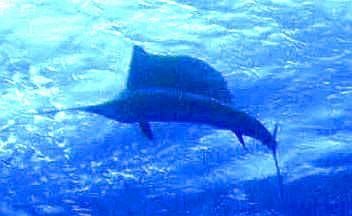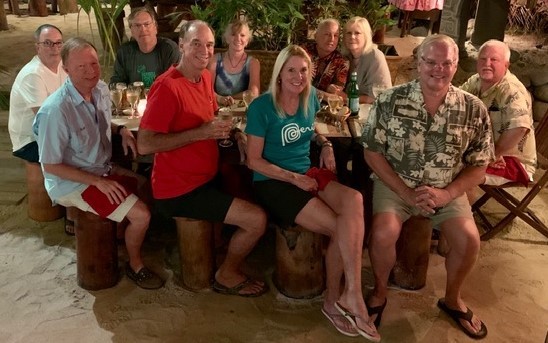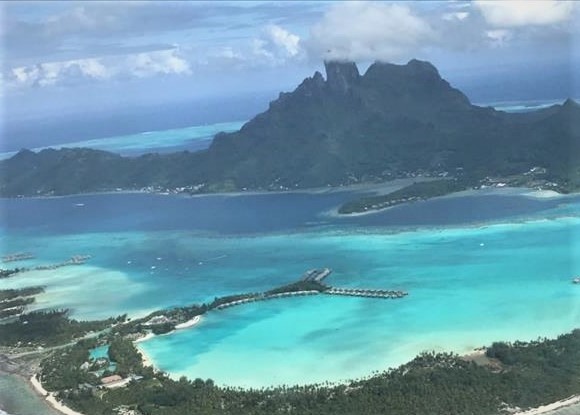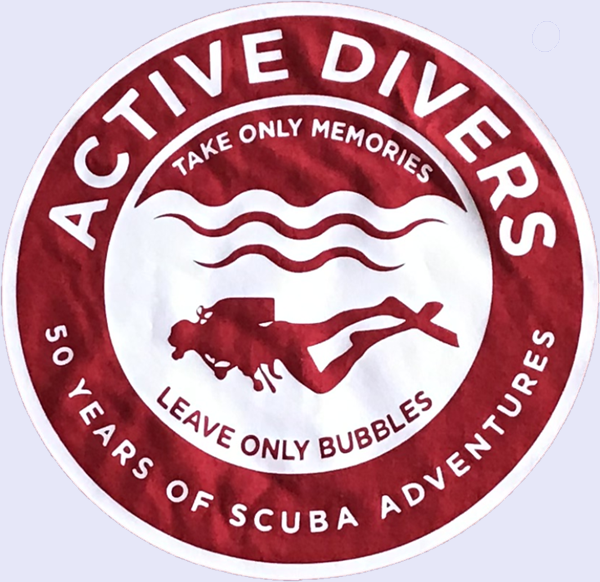![]()
- Tahiti Trip Report
- 13 New Members Learn Coral Restoration
- Get Ready for the 2019 Lobster Season!!
- Mantis Shrimp
- Upcoming Dive Schedule Highlights
- The Aquarius Program
- Bluefin Tuna
- Increases In Turtle Nesting Noted
- Fish Facts
- No-Fault Dive Insurance
- Newsletter Delivery Options
- Email or Address Change?
- T-Shirts For Sale
- Active Divers Guidelines & Policies

The best way to start this story is to say that the beauty of Tahiti is indescribable, and that pictures simply do not do it justice. It truly has to be experienced in person as the 13 individuals brought together by the Active Divers Association did on May 29 to June 17, 2019. Coming from various points in the USA, the first group met in the Papeete (Tahiti) airport early in the morning for a short flight to Moorea and transfer to the Intercontinental Resort and Spa.
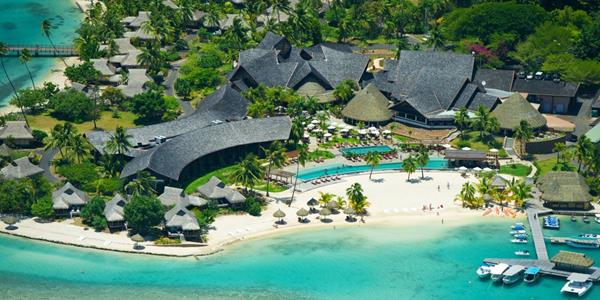 For some, this was a place to rest and recover after
a long flight but ,true to their diving spirit, Terry Longmore and
Roger Bach were the first to go diving the next day (Thursday), while
the rest of the club members waited until Friday morning. Pictured
below is the area where we dove on Friday, just beyond the Paul
Gauguin Cruise ship that we would be boarding on Saturday.
For some, this was a place to rest and recover after
a long flight but ,true to their diving spirit, Terry Longmore and
Roger Bach were the first to go diving the next day (Thursday), while
the rest of the club members waited until Friday morning. Pictured
below is the area where we dove on Friday, just beyond the Paul
Gauguin Cruise ship that we would be boarding on Saturday.
While some commented on the bleaching they saw in the corals, the dive guides said we were just coming into the cool season and they were expecting many of the corals to recover. Let’s be clear though, there is more live coral here than many of us had seen in a long time and plenty of marine life, including black tip sharks.
![]()
--by Roy D. Wasson, Conservation Projects Director
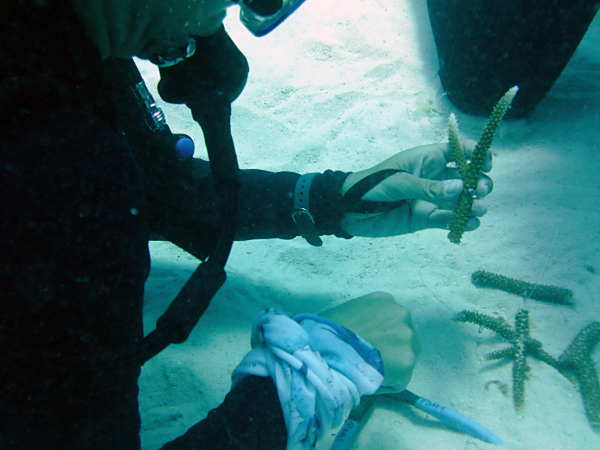 On June 15th,
eleven years after commencing our collaboration with the Coral
Restoration Foundation, the Active Divers Association conducted our
most successful CRF dive program yet. Fifteen Active Divers members,
along with President & Safety Officer Lon Von Lintel, joined CRF
staff for a full day program including classroom and onshore
laboratory work, two working dives, and hours of fun and educational
work in the Upper Keys. The best part of the story is that thirteen of
our Active Divers members diving with us that day were on their first
dive with our club, having found us through the CRF website listing
the program, along with a first-ever link to our membership enrollment
materials.
On June 15th,
eleven years after commencing our collaboration with the Coral
Restoration Foundation, the Active Divers Association conducted our
most successful CRF dive program yet. Fifteen Active Divers members,
along with President & Safety Officer Lon Von Lintel, joined CRF
staff for a full day program including classroom and onshore
laboratory work, two working dives, and hours of fun and educational
work in the Upper Keys. The best part of the story is that thirteen of
our Active Divers members diving with us that day were on their first
dive with our club, having found us through the CRF website listing
the program, along with a first-ever link to our membership enrollment
materials. 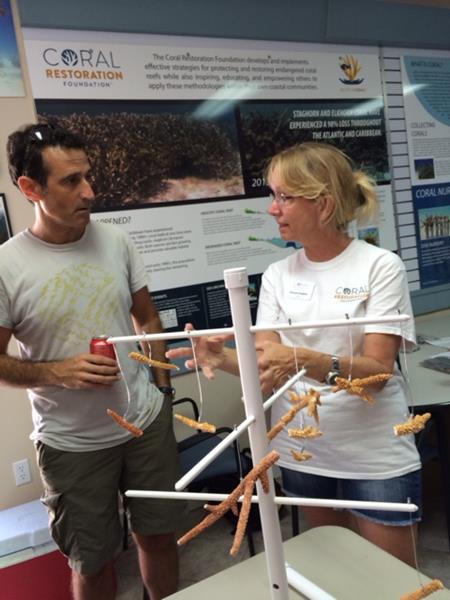
The day started at 9:00 a.m. at CRF’s “Exploration Center” next door
to Pilot House Restaurant on Key Largo. After signing-in and
completing final paperwork, our members attended morning classes to
learn about the causes and effects of coral bleaching, conservation
techniques, and received hands-on training to develop skills in
maintaining coral nurseries and transplanting baby corals onto
blighted reefs. CRF staffers and interns answered questions from our
members, informed us about our plans for working in the water that
day, and made everyone feel very welcome as part of their global
effort to restore our reef system to its former glory. 
After class, we broke for a hearty lunch at Pilot House, which works closely with CRF and provides the building where the Exploration Center is located. Pilot House made sure our group sat together at one long table, where our members exchanged ideas about reef conservation and got to know each other. Making new friends was easy with this dedicated group, two of whom had journeyed down from Connecticut and another new member had traveled all the way from his home in Milwaukee.
After enjoying fresh seafood and other menu favorites, our group made the short drive to Florida Keys Dive Center in Tavernier for the boat trip out to the reefs. After checking in and getting needed gear, our group headed out from the dock to do our work. The weather was nearly perfect for our dive program. Seas of only a foot or two made the trip to the site very comfortable, and cloudy skies kept the temperature down as we made our way to the first dive spot, CRF’s coral nursery. Our two CRF representatives, Jen and J.D., led our groups on the tour, having given us advance notice to watch out for the overly-friendly sea turtle who likes to approach dive groups at the nursery.
![]()

The dreaded spiny lobster...
This year the mini season falls on July 24th and 25th. Make sure to always verify dates and regulations at http://myfwc.com/fishing/saltwater/recreational/lobster/. It begins at 12:01 am on Wednesday and ends at 12:00 midnight on Thursday. The regular 8 month lobster season is always August 6 through March 31. Make sure and check with the dive shop that you are going into an area where lobster can be taken- most areas of the Florida Keys Marine Sanctuary are no-take zones.
Most Florida diver fatalities ( https://www.flkeysnews.com/news/local/article86984917.html) occur during the lobster mini season, where every unprepared diver goes out at midnight on overcrowded dive boats with many divers that have not been in the water for a year or more.
First things first, make sure that you get your equipment serviced soon since the dive shops will get overloaded the closer you get to lobster season, and you will pay more and get slower service. And there is always the possibility that someone in a hurry will not service your equipment properly. So, I recommend that you go diving at least once before the lobster season after your equipment has been serviced to make sure everything is working correctly.
 There are a lot of ways to catch a lobster, but my
favorite is with a lobster loop. Lobster instinctively walk backwards
when they feel threatened, so you place the loop behind the tail and
tickle them a bit to get them to move backwards. Once the tail is in
the loop you pull back hard on the handle so that the loop contracts
around the tail and captures the beast! Always make sure that you have
a measuring device with you to check and make sure the lobster meets
the minimum requirements between the shell and the carapace. You
CANNOT bring only a lobster tail up from a dive! You must bring the
entire lobster up in case the boat gets stopped by the Marine Patrol
to verify your catch is legal. Furthermore, you cannot take egg
bearing females, which are apparent by the bundle of red eggs (looks
like carpeting) on their belly.
There are a lot of ways to catch a lobster, but my
favorite is with a lobster loop. Lobster instinctively walk backwards
when they feel threatened, so you place the loop behind the tail and
tickle them a bit to get them to move backwards. Once the tail is in
the loop you pull back hard on the handle so that the loop contracts
around the tail and captures the beast! Always make sure that you have
a measuring device with you to check and make sure the lobster meets
the minimum requirements between the shell and the carapace. You
CANNOT bring only a lobster tail up from a dive! You must bring the
entire lobster up in case the boat gets stopped by the Marine Patrol
to verify your catch is legal. Furthermore, you cannot take egg
bearing females, which are apparent by the bundle of red eggs (looks
like carpeting) on their belly.
Iif you are under the age of 65, you must have a Florida saltwater fishing license and a Lobster stamp in order to hunt them. They can be obtained online at http://myfwc.com/fishing/ for a reasonable fee and you must have them with you.
Finally, once you get to the dock you need to clean them, and I will be glad to tell you how the next time I see you on a dive. If you can't wait, call me at 954-591-1161— it’s just a bit too graphic to put in a newsletter!!
![]()

The Mantis Shrimp: Its size ranges
from 4 to 18 inches long.
The mantis shrimp is known for its’ claw or claws which is more appropriate. They are some tough hardware to have. They can be used to smash snails and clams. Okay, I can do a snail but no way can I do a clam. That is quite a feat in and of itself. Another amazing fact is how quickly they can launch an attack It is estimated to be 50 times faster than your eye blink. Hmmm, that is pretty fast.
This type shrimp is usually not in a fish tank. Any guesses why? It is because they can punch through it. More importantly, they kill all the other sea creatures in the tank.Doesn't lay well with others. Not good pets for sure. Some other observations of these creatures reveal they groan to attract mates, hmmmmm, that’s a little like us humans. But we don’t create bubbles when we move to knock out the prey. We also don’t kick our feet about 75 times per second. And we definitely don’t have eyes bigger than our brains, at least most of us don’t.
Then, there is that hearing with the hair on its’ body. We, or at least I, don’t have that ability. Maybe Hollywood could take a couple hints here and add this to a super hero. Lately, they seem to be able to do anything. Finally, this creature sees more colors than any other animal. Now that ability I would love to have.
For a look at the Mantis Shrimp in action, click here to see this short National Geographic video.
![]()
Dive season is in full swing, and there are some awesome upcoming dives featuring interesting experiences on the Active Divers schedule for 2019. Check out these upcoming dives:
Sea Turtle Dive - July 6: When we had the chance to check out Jupiter Scuba Diving And their boat the Kyalami I’m February we saw about a dozen turtles. The Divemaster on the boat told us that during the height of sea turtle nesting season from mid-June to mid-July you could see up to 50 turtles on a single dive. So we scheduled this dive for July 6 with that in mind. Plus the Kyalami is a great operation, docked at the famous Square Grouper tiki bar, to make a perfect end to a perfect dive day. See this video from February’s dive: https://youtu.be/VoYErREXPhw
Tenneco Towers - July 14: This series of sunken oil platforms near Fort Lauderdale makes for a very unusual and interesting deep Wreck dive. The platforms have been there for many years and are well encrusted with corals. This site also attracts many fish.
 Looe
Key And Key West - August 3-4: This is our annual
excuse to get down to the lower Keys each year. The Looe Key National
Marine sanctuary boasts incredible finger reefs, and the famous Looe
Key Resort And Tiki Bar is a Florida Keys tradition offering modest
accommodations at reasonable rates with easy access to all of Key
West’s famous attractions. For Active Divers, this includes the
Vandenburg, one of our best deep wrecks in the Florida Keys. This
large wreck complete with swim-through satellite dishes is sure to be
a highlight of your trip to Key West.
Looe
Key And Key West - August 3-4: This is our annual
excuse to get down to the lower Keys each year. The Looe Key National
Marine sanctuary boasts incredible finger reefs, and the famous Looe
Key Resort And Tiki Bar is a Florida Keys tradition offering modest
accommodations at reasonable rates with easy access to all of Key
West’s famous attractions. For Active Divers, this includes the
Vandenburg, one of our best deep wrecks in the Florida Keys. This
large wreck complete with swim-through satellite dishes is sure to be
a highlight of your trip to Key West.
Islamorada Night Dive - August 17: If you’ve never experienced a night dive before, this is your chance. Many times critters we rarely see during the daylight hours come alive at night. Lobsters walking around in plain view, sleeping parrotfish, crabs, sea stars, large open basket stars and octopus are frequently observed on a night dive. Even if you’ve never tried night diving, our Safety Officers will guide you through.
 Goliath
Grouper dive - September 14: Last year I spoke to
the legendary Jim Abernathy about the best time to see the annual
Goliath Grouper aggregation that occurs in the waters off West Palm
Beach. He said the aggregation peaks in the days around the full moon
in September. This year the full moon is the day of our dive and we
will witness their amazing aggregation. See for yourself in our video
from last September’s dive: https://youtu.be/NUt6d8pn224
Goliath
Grouper dive - September 14: Last year I spoke to
the legendary Jim Abernathy about the best time to see the annual
Goliath Grouper aggregation that occurs in the waters off West Palm
Beach. He said the aggregation peaks in the days around the full moon
in September. This year the full moon is the day of our dive and we
will witness their amazing aggregation. See for yourself in our video
from last September’s dive: https://youtu.be/NUt6d8pn224
Spiegel Grove - September 22: This is one of the premier wrecks in South Florida. It’s so large it takes many dives to see it all. Eight down lines reach all parts of this massive wreck. Also check out the Duane (August 11) and the Eagle (October 6) if you like big wrecks.
Blue Heron Bridge - November 16: Lastly, we cap off the dive season with our end of season picnic at the bridge, offering unusual sightings such as a resident batfish, octopus and a plethora of large yellow cushion sea stars. See our video from the first kickoff picnic at the bridge on April 6 this year: https://youtu.be/kpeDAbWD16E
Whatever kind of diving your into, our dive schedule offers something for everyone. See you on the boat!!!
![]()
Hello Active Divers Association members I am Franco Calvo and I’ve had the privilege of being a member of the association since 2014.
Since that time on I’ve had the privilege of diving with some of the most seasoned divers in south Florida. Not only have I enjoyed the start of the season BBQ’s held at Dr. Von D. Mizell-Eula Johnson State Park but multiple dives to the keys and elsewhere.
One of the most incredible experiences I had was of being one of the very few divers (less than 1500) to have had the opportunity to enter the Aquarius Reef Base and becoming an aquanaut.
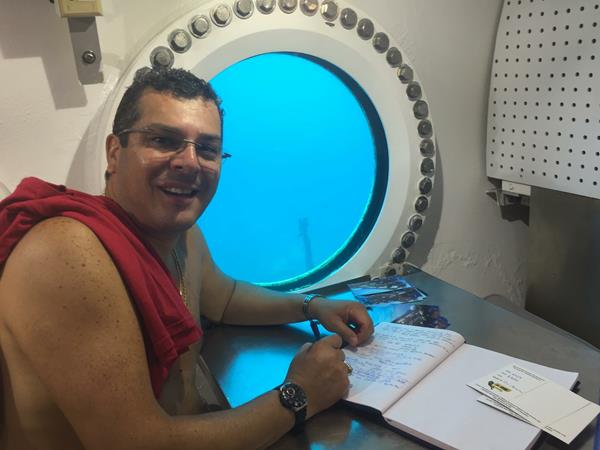 The Aquarius
Reef Base is an underwater habitat located 5.4 miles (9 kilometers)
off Key Largo in the Florid Keys National Marine Sanctuary. It
is deployed on the ocean floor 62 feet (19 meters) below the surface
and next to a deep coral reef named Conch Reef.
The Aquarius
Reef Base is an underwater habitat located 5.4 miles (9 kilometers)
off Key Largo in the Florid Keys National Marine Sanctuary. It
is deployed on the ocean floor 62 feet (19 meters) below the surface
and next to a deep coral reef named Conch Reef.
Aquarius is one of three undersea laboratories in the world dedicated to science and education. Two additional undersea facilities, also located in Key Largo, FL are owned and operated by Marine Resources Development Foundation. Aquarius was owned by the National Oceanic and Atmospheric Administration (NOAA) and operated by the University of North Carolina - Wilmington [1] until 2013 when Florida International University assumed operational control.[2] Florida International University (FIU) took ownership of Aquarius in October 2014. As part of the FIU Marine Education and Research Initiative, the Medina Aquarius Program is dedicated to the study and preservation of marine ecosystems worldwide and is enhancing the scope and impact of FIU on research, educational outreach, technology development, and professional training. At the heart of the program is the Aquarius Reef Base.
This year as I came back home to Hallandale Beach from a work relocation to Los Angeles, CA for almost two years I received a call from one of our Board members, Roy Wasson, who asked me to be the chairman for the association to organize a new expedition for next year. Having said that I asked all of our members, specially those who have previously participated in the habitat experience, to reach out to me to assist us in making this new venture as successful as the one organized in 2016. Thank you.
Safe dives,
Franco
[1] https://en.wikipedia.org/wiki/University_of_North_Carolina_at_Wilmington
[2] https://en.wikipedia.org/wiki/Florida_International_University
![]()
At one time the bluefin was made for cat food. Shortly thereafter a 200-pound Blue Fin was worth $100,000 in the Tokyo market. It was now a favorite sushi fish, with a couple little pieces on top of some rice costing $100.00. Did you know that the Blue fin had a couple songs about it? The “Song for the Blue Ocean and “Tuna A Love Story” Strange indeed.
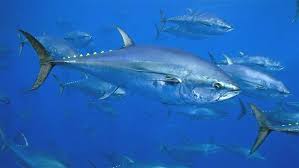 Bluefins
adult females release millions of eggs but very few survive. Now, it
appears that small fraction might not be enough to produce enough to
insure their survival. It turns out the eggs stay on the surface. This
is bad because that is why they get eaten. It makes great and easy
prey for the other animals.
Bluefins
adult females release millions of eggs but very few survive. Now, it
appears that small fraction might not be enough to produce enough to
insure their survival. It turns out the eggs stay on the surface. This
is bad because that is why they get eaten. It makes great and easy
prey for the other animals.
But then they do some harm also. A tuna eats a lot also. It is estimated that it may be a thousand pounds of food needed to make one pound of tuna. Now when the oceans were full that was no problem, but the oceans are not the same anymore. They have a tough time to gain weight. I mean who likes a skinny tuna? Let’s hope this species makes it thru the current crises. Just recall, it is never too late to change things.
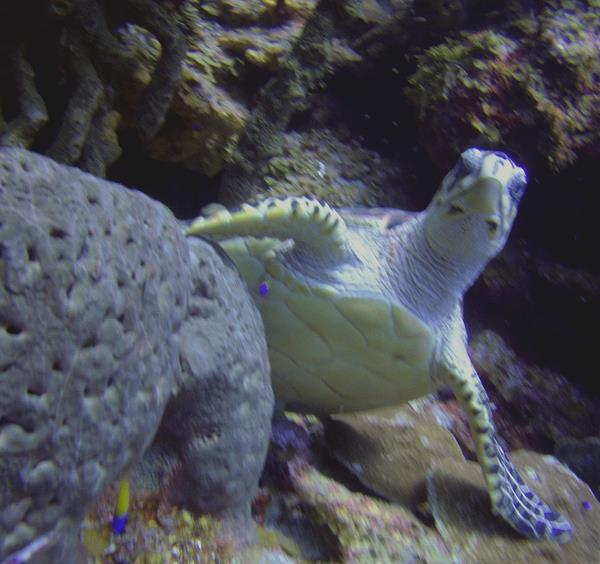 The Florida National Estuaries Research Reserves
report that during the 2019 nesting season there have been amazing
increases in the counted nesting sites throughout Florida. At St
George and Little St George islands there were 139 loggerhead, 2
green, and one leatherback nests, a 130% increase over last year.
Ponte Verde had 99 vs 30 a year ago, a 230% increase. Naples beaches
had 512 vs 306 last year. The reason for the yearly differences is
unknown. If you see a sick, injured, or stranded turtle, call the
Florida Fish and Wildlife Conservation Commission at 888-404-3922
The Florida National Estuaries Research Reserves
report that during the 2019 nesting season there have been amazing
increases in the counted nesting sites throughout Florida. At St
George and Little St George islands there were 139 loggerhead, 2
green, and one leatherback nests, a 130% increase over last year.
Ponte Verde had 99 vs 30 a year ago, a 230% increase. Naples beaches
had 512 vs 306 last year. The reason for the yearly differences is
unknown. If you see a sick, injured, or stranded turtle, call the
Florida Fish and Wildlife Conservation Commission at 888-404-3922
Want your newsletter delivered via snail-mail? Contact the webmaster and request a printed copy. Be sure to put "Active Divers Newsletter" in the subject.
![]()
If so, please email or call us with your current information. You may send an email to: Dr. Dan Baeza, Membership Chair at ActiveDiversInfo@gmail.com. You can also call Dan at 954-260-8225 and leave a message with your new contact information.
![]()
1. True or False? A jellyfish is a fish/
2 True or False? A seahorse is a fish.
3. True or False? A starfish is a fish/
Active Divers T-Shirts For Sale
We've revamped our logo! Show your pride in the best dive club anywhere and pick up a tee with a brand new logo. Hover over the t-shirt to see the logo in detail. Sizes small, medium, large, xlarge, xxlarge. Some tank tops available also. All shirts are $10 each. CALL LON AT 305-251-4975 AND PLACE YOUR ORDER TODAY!. Lon will deliver it to you on your next dive
Did you know that Active Divers offers dive insurance? You may have noticed the "Dive + Insurance" option when purchasing a dive on our schedule page. For a $5 fee at the time of booking your local dive, you may insure your dive fee against any unforeseen problem that could preclude you from making the dive.
If for any reason you are unable to attend a local dive for which you are scheduled and have paid the insurance, Active Divers will credit your dive fee to another date. The $5.00 insurance is non-transferable and non-refundable.
For more information, see the "Active Divers Trip Cancellation Insurance" description at https://activedivers.org/Guidelines.html.If you have additional questions, please send us an email message at ActiveDiversInfo@gmail.com.
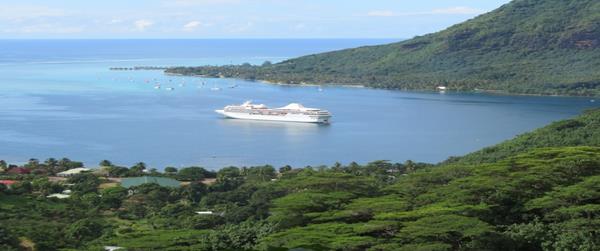 On
Saturday June 1, we took a short ferry ride back to the Papeete port
where we took a five-minute walk to board the Paul Gauguin. From the
instant we boarded the ship it was clear that we were going to be
treated to service at a level higher than most cruise lines offer.
At times I felt almost like they were doing too much for me! I won’t
go into the details of the itinerary but we visited a different
island almost every day where there were abundant land and
water-based excursions to choose from. The feature that sets the
Paul Gauguin apart from most cruise ships is the marina at the rear
of the ship (see picture below) where dives are staged (with nitrox)
and free water sports equipment that can be used in most ports,
including kayaks and paddle boards.
On
Saturday June 1, we took a short ferry ride back to the Papeete port
where we took a five-minute walk to board the Paul Gauguin. From the
instant we boarded the ship it was clear that we were going to be
treated to service at a level higher than most cruise lines offer.
At times I felt almost like they were doing too much for me! I won’t
go into the details of the itinerary but we visited a different
island almost every day where there were abundant land and
water-based excursions to choose from. The feature that sets the
Paul Gauguin apart from most cruise ships is the marina at the rear
of the ship (see picture below) where dives are staged (with nitrox)
and free water sports equipment that can be used in most ports,
including kayaks and paddle boards.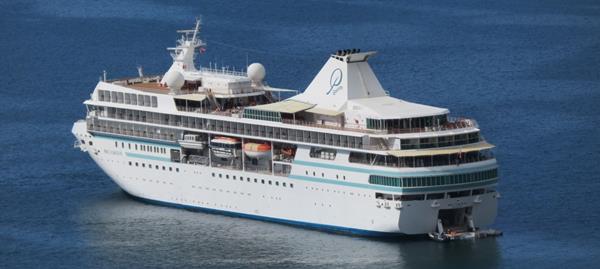

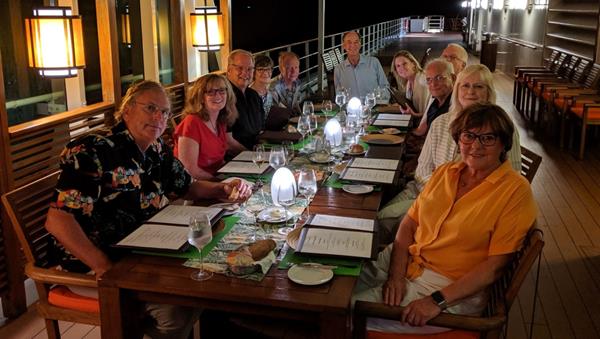
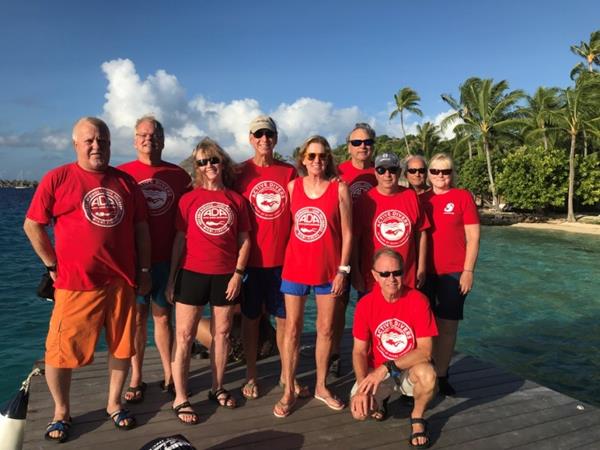
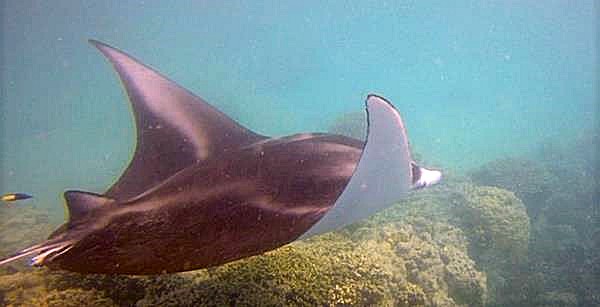 You would
expect the first dive in a new foreign location to be a “check out”
mundane dive, but instead we were treated to dive at Fafatipi
(Tahitian for Manta Rays) and yes, we saw many of them! (Underwater
pictures courtesy of Sandy Workman and Terry Longmore)
You would
expect the first dive in a new foreign location to be a “check out”
mundane dive, but instead we were treated to dive at Fafatipi
(Tahitian for Manta Rays) and yes, we saw many of them! (Underwater
pictures courtesy of Sandy Workman and Terry Longmore) 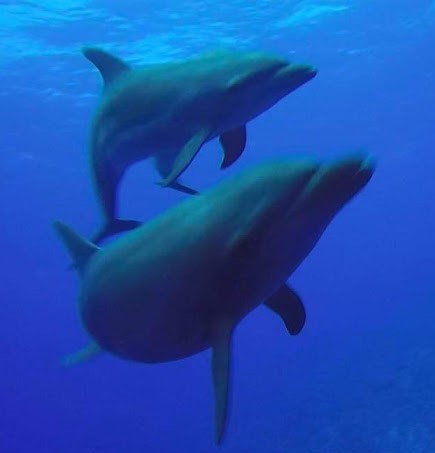 The next dive
was on a site outside the lagoon known for sharks and we saw black
tips, large lemon sharks, fields of coral and a plethora of
tropicals. We did six more dives that week and we were able to dive
all but one of the Bora Bora dive sites. We also managed to visit
some local famous restaurants in the evening, including “Bloody
Marys” We left for Rangiroa on Thursday, June 13 with anticipation
of some really great diving- and we were not disappointed! Seven
divers went out on the first afternoon we arrived and were
approached by some friendly dolphins in about 80 feet of water that
knew the local dive masters. They were waiting to “play” with us and
welcomed being touched by us much to our surprise. Again, these were
dolphins in the wild and not trained in a pool!!
The next dive
was on a site outside the lagoon known for sharks and we saw black
tips, large lemon sharks, fields of coral and a plethora of
tropicals. We did six more dives that week and we were able to dive
all but one of the Bora Bora dive sites. We also managed to visit
some local famous restaurants in the evening, including “Bloody
Marys” We left for Rangiroa on Thursday, June 13 with anticipation
of some really great diving- and we were not disappointed! Seven
divers went out on the first afternoon we arrived and were
approached by some friendly dolphins in about 80 feet of water that
knew the local dive masters. They were waiting to “play” with us and
welcomed being touched by us much to our surprise. Again, these were
dolphins in the wild and not trained in a pool!! 